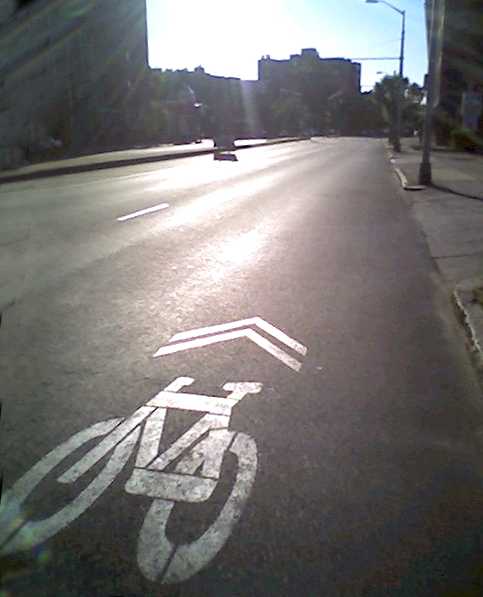 The only thing worse than being hit by a car on a bicycle is hitting someone else with your car while they’re on a bicycle.
The only thing worse than being hit by a car on a bicycle is hitting someone else with your car while they’re on a bicycle.
For starters, meet the “sharrow”. A sharrow, or “shared arrow” is shown on the right. This design indicates that bicycles and cars should share full use of the lane. If you’re behind a slow moving bicycle, treat it like any other slow moving vehicle. If you’re on your bike, look for reasonable and safe opportunities to let cars pass you.
Treat a bike lane like any other lane.
As the Bay Citizen’s data shows, bicyclists are everywhere – not just on streets with bike lanes and signs.
The Californi DMV offers these words of advice (actually, requirement) to help drivers reduce their risk of injuring others.
- At intersections without “STOP” or “YIELD” signs, slow down and be ready to stop. Yield to traffic and pedestrians already in the intersection or just entering the intersection. Also, yield to the vehicle or bicycle which arrives first, or to the vehicle or bicycle on your right if it reaches the intersection at the same time as you.
- Do not obstruct bicycle traffic by reducing the width required for safe bicycle passage, typically three to four feet.
- When you are making a right turn and are within 200 feet of the corner or other driveway entrance, you must enter the bicycle lane only after ensuring there is no bicycle traffic,and then make the turn. Do not drive in the bicycle lane at any other time.
- You may park in a bicycle lane if your vehicle does not block a bicyclist and/or there is not a “No Parking” sign posted.
- When passing a bicyclist in the travel lane ensure enough width for the bicyclist, typically 3 feet. Do not squeeze a bicyclist off the road.
- Bicyclists may occupy the center of the lane when conditions such as a narrow lane or road hazard make it unsafe to ride in a position that may provide room for a vehicle to pass.
- With any slow-moving vehicle, drivers should follow at a safe distance. When it is safe the bicyclists should move to a position that allows vehicles to pass.
- Allow sufficient clearance, and ample room for movement and unexpected road conditions.
- Always look carefully for bicyclists before opening doors next to moving traffic or before turning.
- Allow bicyclists enough room to avoid colliding with vehicle doors that are opened into traffic.
- Do not try to pass a bicyclist just before making a turn. Merge safely where it is allowed, then turn.
- Make a visual check for bicyclists when changing lanes or entering traffic. Bicycles are small and may be hidden in a vehicle’s blind spot.
- Be careful when approaching or passing a bicyclist on a two lane highway or freeway.
Do you have anything to add?
